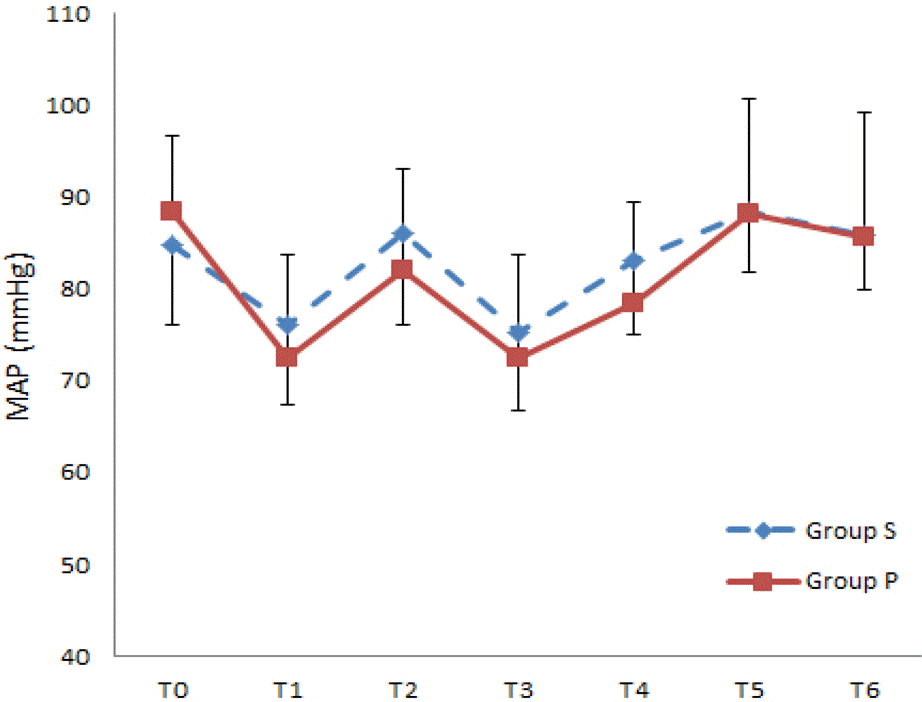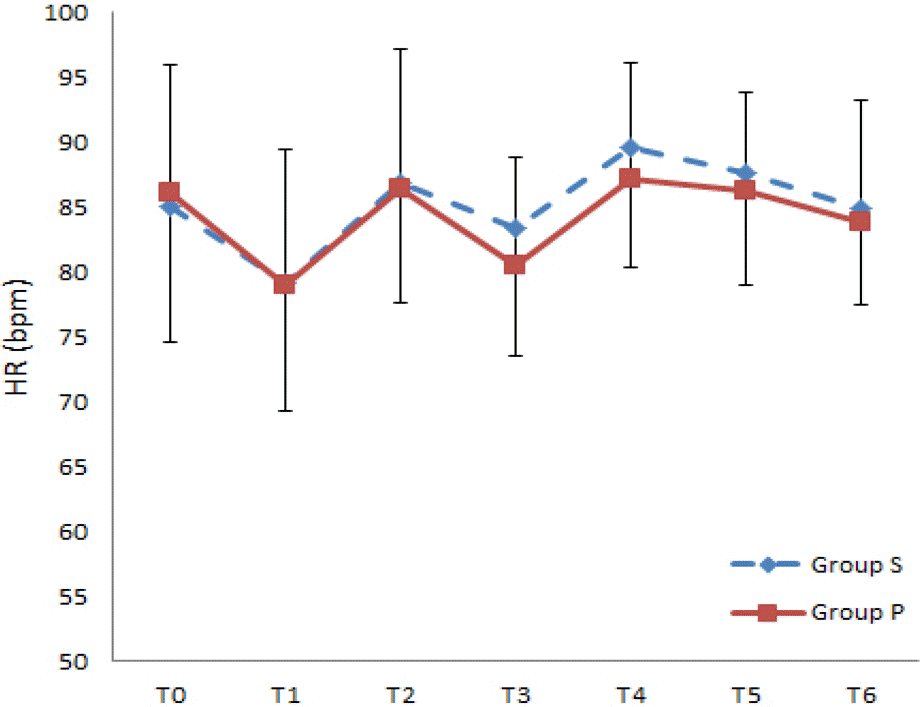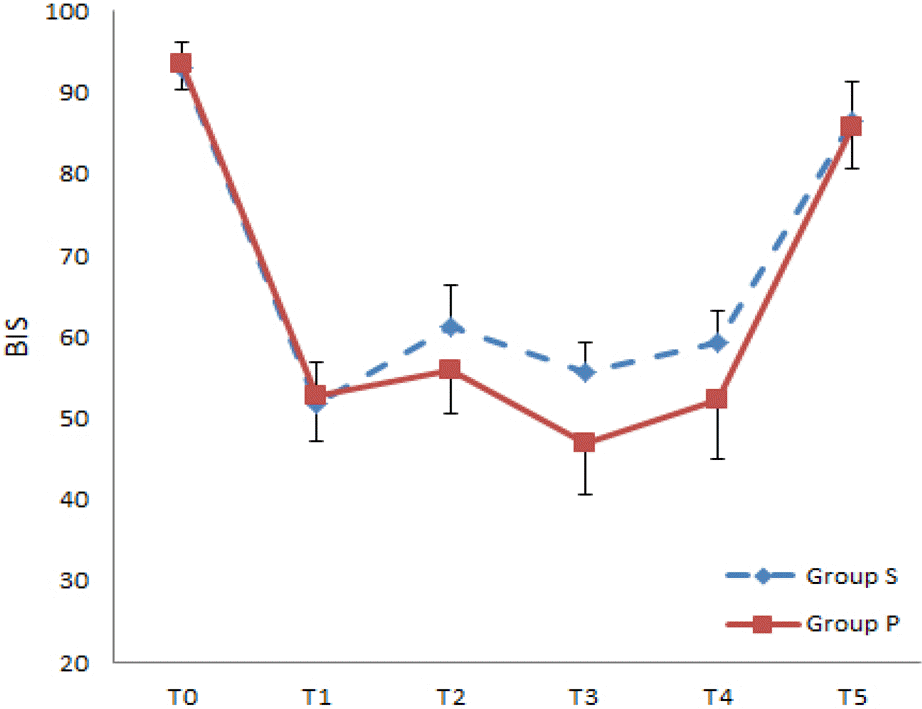Abstract
Objectives
This study was investigated the recovery characteristics of propofol-remifentanil and sevoflurane-remifentanil anesthesia for total thyroidectomy
Methods
Eighty patients in ASA physical status 1 and 2 scheduled for total thyroidectomy were allocated randomly to either group P (n = 40) or group S (n = 40). Anesthesia was maintained with remifentanil effect site concentration (Ce) 1-3 ng/mL and propofol Ce 2-4 μ g/mL in the group P, and was maintained with remifentanil Ce 1-3 ng/mL and sevoflurane 1.5-2% in the group S. Blood pressure, heart rate, and bispectral (BIS) index were measured during perioperative period. The times from discontinuance of anesthetic agent to eye opening, to extubation, and to stating name were measured. Postoperative complications were evaluated.
Objectives
This study was investigated the recovery characteristics of propofol-remifentanil and sevoflurane-remifentanil anesthesia for total thyroidectomy
Methods
Eighty patients in ASA physical status 1 and 2 scheduled for total thyroidectomy were allocated randomly to either group P (n = 40) or group S (n = 40). Anesthesia was maintained with remifentanil effect site concentration (Ce) 1-3 ng/mL and propofol Ce 2-4 μ g/mL in the group P, and was maintained with remifentanil Ce 1-3 ng/mL and sevoflurane 1.5-2% in the group S. Blood pressure, heart rate, and bispectral (BIS) index were measured during perioperative period. The times from discontinuance of anesthetic agent to eye opening, to extubation, and to stating name were measured. Postoperative complications were evaluated.
Results
There were no significant differences between group P and S on the blood pressure, heart rate, and recovery time. BIS index of group P showed lower than that of group S during operation (P < 0.05). The incidences of side effects were similar in the two groups, though the incidence of nausea was higher in the group S (P < 0.05).
Go to : 
REFERENCES
1.Jung KW., Won YJ., Kong HJ., Oh CM., Seo HG., Lee JS. Cancer Statistics in Korea: Incidence, Mortality, Survival and Prevalence in 2010. Cancer Res Treat. 2013. 45:1–14.

2.Joe HB., Park EJ., Park SK., Kim EJ., Park JH., Choi JW, et al. The effects of prophylactic dolasetron and induction with propofol on postoperative nausea and vomiting after thyroidectomy. Korean J Anesthesiol. 2009. 57:320–6.

3.Wang JJ., Ho ST., Lee SC., Liu YC., Liu YH., Liao YC. The prophylactic effect of dexamethasone on postoperative nausea and vomiting in women undergoing thyroidectomy: a comparison of droperidol with saline. Anesth Analg. 1999. 89:200–3.
4.Fujii Y., Saitoh Y., Tanaka H., Toyooka H. Prophylactic antiemetic therapy with granisetron in women undergoing thyroidectomy. Br J Anaesth. 1998. 81:526–8.

5.Golembiewski J., Chernin E., Chopra T. Prevention and treatment of postoperative nausea and vomiting. Am J Health Syst Pharm. 2005. 62:1247–60.

6.Edmond I Eger II. Inhaled anesthetics: uptake and distribution. In: Miller RD, editors. Miller's anaesthesia. 7th ed. Philadelpia, Elsevier, 2010, p. 540–2.
7.TerRiet MF., DeSouza GJA., Jacobs JS., Young D., Lewis MC., Herrington C, et al. Which is most pungent: isoflurane, sevoflurane or desflurane? Br J Anaesth. 2000. 85:305–7.

8.Jeong JH., Song SO., Kim HD. A comparison of the recovery characteristics of propofol and sevoflurane anesthesia under bispectral index system monitoring. Korean J Anesthesiol. 2004. 46:528–34.

9.Sneyd JR., Carr A., Byrom WD., Bilski AJ. A meta-analysis of nausea and vomiting following maintenance of anaesthesia with propofol or inhalational agents. Eur J Anaesthesiol. 1998. 15:433–45.

10.Fredman B., Nathanson MH., Smith I., Wang J., Klein K., White PF. Sevoflurane for outpatient anesthesia: a comparison with propofol. Anesth Analg. 1995. 81:823–8.
11.Lien CA., Hemmings HC., Belmont MR., Abalos A., Hollmann C., Kelly RE. A comparison: the efficacy of sevoflurane-nitrous oxide or propofol-nitrous oxide for the induction and maintenance of general anesthesia. J Clin Anesth. 1996. 8:639–43.

12.Wandel C., Neff A., Böhrer H., Browne A., Motsch J., Martin E. Recovery characteristics following anaesthesia with sevoflurane or propofol in adults undergoing out-patient surgery. Eur J Clin Pharmacol. 1995. 48:185–8.

13.Larsen B., Seitz A., Larsen R. Recovery of cognitive function after remifentanil-propofol anesthesia: a comparison with desflurane and sevoflurane anesthesia. Anesth Analg. 2000. 90:168–74.

14.Nelskylä K., Korttila K., Yli-Hankala A. Comparison of sevoflurane-nitrous oxide and propofol-alfentanil-nitrous oxide anaesthesia for minor gynaecological surgery. Br J Anaesth. 1999. 83:576–9.

15.Raeder J., Gupta A., Pedersen FM. Recovery characteristics of sevoflurane- or propofol-based anaesthesia for day-care surgery. Acta Anaesthesiol Scand. 1997. 41:988–94.

16.Choi CH., Jeong SW., Chung ST., Bae HB., Choi JI., Chung SS, et al. Comparison of anesthetic techniques for preventing postoperative nausea and vomiting undergoing thyroidectomy. Korean J Anesthesiol. 2006. 51:449–54.

17.Korttila K., Ostman P., Faure E., Apfelbaum JL., Prunskis J., Ekdawi M, et al. Randomized comparison of recovery after propofol-nitrous oxide versus thiopentone-isoflurane-nitrous oxide anaesthesia in patients undergoing ambulatory surgery. Acta Anaesthesiol Scand. 1990. 34:400–3.

18.Price ML., Walmsley A., Swaine C., Ponte J. Comparison of a total intravenous anaesthetic technique using a propofol infusion, with an inhalational technique using enflurane for day case surgery. Anaesthesia. 1988. 43:S84–7.

19.Felts JA., Poler SM., Spitznagel EL. Nitrous oxide, nausea, and vomiting after outpatient gynecologic surgery. J Clin Anesth. 1990. 2:168–71.

20.Pandit UA., Malviya S., Lewis IH. Vomiting after outpatient tonsilectomy and adenoidectomy in children: the role of nitrous oxide. Anesth Analg. 1995. 80:230–3.
21.Appadu BL., Strange PG., Lambert DG. Does propofol interact with D2 dopamine receptors? Anesth Analg. 1994. 79:1191–2.

22.Chanvej L., Kijsirikul S., Thongsuksai P., Naheem L. Postoperative nausea and vomiting in out-patient gynecologic laparoscopy: a comparison of thiopental-nitrous oxide, propofol-nitrous oxide and total intravenous anesthesia using propofol. J Med Assoc Thai. 2001. 84:697–704.
23.Chia YY., Lee SW., Liu K. Propofol causes less postoperative pharyngeal morbidity than thiopental after the use of a laryngeal mask airway. Anesth Analg. 2008. 106:123–6.

24.Gan TJ., Ginsberg B., Grant AP., Glass PS. Double-blind, randomized comparison of ondansetron and intraoperative propofol to prevent postoperative nausea and vomiting. Anesthesiology. 1996. 85:1036–42.

25.Soppitt AJ., Glass PS., Howell S., Weatherwax K., Gan TJ. The use of propofol for its antiemetic effect: a survey of clinical practice in the United States. J Clin Anesth. 2000. 12:265–9.

26.Watcha MF., White PF. Postoperative nausea and vomiting. It's etiology, treatment, and prevention. Anesthesiology. 1992. 77:162–84.
27.Glass PS., Gan TJ., Howell S. A review of the pharmacokinetics and pharmacodynamics of remifentanil. Anesth Analg. 1999. 89:7–14.

28.Dershwitz M., Michalowski P., Chang Y., Rosow CE., Conlay LA. Postoperative nausea and vomiting after total intravenous anesthesia with propofol and remifentanil or alfentanil: how important is the opioid? J Clin Anesth. 2002. 14:275–8.

29.Tramer M., Moore A., McQuay H. Propofol anaesthesia and postoperative nausea and vomiting: quantitative systematic review of randomized controlled studies. Br J Anaesth. 1997. 78:247–5.
Go to : 
 | Fig. 1.Perioperative changes of mean arterial pressure (MAP). T0, 2 minutes before the induction; T1, right before the endotracheal intubation; T2, right after the endotracheal intubation; T3, right before the beginning of operation; T4, right after the beginning of operation; T5, right before the extubation; T6, postanesthetic care unit (PACU). Group P, propofol and remifentanil; Group S, sevoflurane and remifentanil. Each data was shown as mean ± SD (between groups: P = 0.465). |
 | Fig. 2.Perioperative changes of heart rate (HR). T0, 2 minutes before the induction; T1, right before the endotracheal intubation; T2, right after the endotracheal intubation; T3, right before the beginning of operation; T4, right after the beginning of operation; T5, right before the extubation; T6, postanesthetic care unit (PACU). Group P, propofol and remifentanil; Group S, sevoflurane and remifentanil. Each data was shown as mean ± SD (between groups: P = 0.691). |
 | Fig. 3.Perioperative change of bispectral (BIS) index. T0, 2 minutes before the induction; T1, right before the endotracheal intubation; T2, right after the endotracheal intubation; T3, right before the beginning of operation; T4, right after the beginning of operation; T5, right before the extubation. Group P, propofol and remifentanil; Group S, sevoflurane and remifentanil. Each data was shown as mean ± SD (between groups: P = 0.001). |
Table 1.
Characteristics of patients
Table 2. Emergence
times from discontinuance of anesthetic drug
| Group P (n = 40) | Group S (n = 40) | |
|---|---|---|
| Time to eye opening (min) | 11.2 ± 2.7 | 10.4 ± 1.9 |
| Time to extubation (min) | 11.9 ± 2.4 | 11.1 ± 1.9 |
| Time to stating name (min) | 14.1 ± 2.2 | 14.5 ± 2.4 |




 PDF
PDF ePub
ePub Citation
Citation Print
Print


 XML Download
XML Download